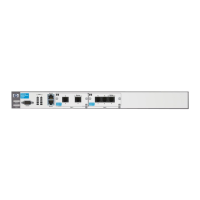7-54
ADSL WAN Connections
Troubleshooting the ADSL Connection
When you view the status of the PPP interface, you must ensure that both the
interface and the Network Layer protocol are up. For example, Figure 7-25
shows a PPP interface that is up. However, the user cannot send traffic over
the link. If you look more closely at Figure 7-25, you can see the reason: the
Network Layer protocol—IP—is down.
Figure 7-25. The PPP interface is up, but IP is down.
To determine why IP is down, use the debug ppp commands. Table 7-8 lists
the debug commands you can use to monitor PPP interfaces.
Table 7-8. debug ppp Commands
ppp 1 is UP
Configuration:
Keep-alive is set (10 sec.)
No multilink
MTU = 1492
No authentication
IP is configured
192.168.1.20 255.255.255.0
Link thru atm 1.1 is UP; LCP state is OPENED, negotiated MTU is 1492
Receive: bytes=3596, pkts=442, errors=0
Transmit: bytes=3508, pkts=292, errors=0
5 minute input rate 624 bits/sec, 1 packets/sec
5 minute output rate 496 bits/sec, 1 packets/sec
Bundle information
Queueing method: fifo
HDLC tx ring limit: 0
Output queue: 0/1/200/0 (size/highest/max total/drops)
IP is DOWN, IPCP state is REQSENT
LLDPCP State is REQ SENT
First, make sure the interface is up
Next, ensure that IP is up
Command Explanation
debug ppp verbose displays detailed information about all PPP
frames as they arrive on the PPP interface
debug ppp errors displays error messages relating to PPP
debug ppp negotiations displays events relating to link negotiation;
shows if links protocols are able to open; and
reveals when negotiations between two PPP
peers fail
debug ppp authentication displays real-time messages relating to PAP
and CHAP
undebug all turns off debug messages

